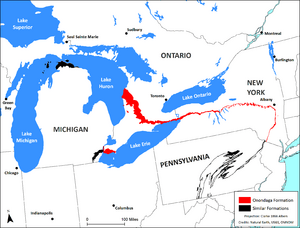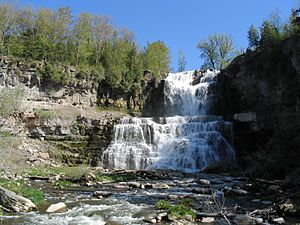Onondaga Limestone facts for kids
Quick facts for kids Onondaga LimestoneStratigraphic range: Eifelian-Givetian ~392–383Ma |
|
|---|---|
| Type | Geological formation |
| Sub-units | Seneca, Moorehouse, Nedrow, Edgecliff |
| Underlies | Hamilton Group and Marcellus Formation |
| Overlies | Helderberg Group, Old Port Formation, Oriskany Sandstone, and Schoharie Formation |
| Lithology | |
| Primary | Limestone |
| Location | |
| Region | Maryland, New York, and Ohio |
| Country | |
| Extent | Appalachian Basin of eastern North America |
| Type section | |
| Named for | Onondaga, NY |
 Location of the Onondaga limestone outcrop in New York State, USA and Ontario, Canada |
|
The Onondaga Limestone is a type of hard rock. It is made of limestone and dolomite. This rock formed during the Devonian period, millions of years ago. In some places, it creates important land features. In other areas, especially in southern Southern Ontario, it is not as easy to see.
In upstate New York and southern Ontario, these rocks gently slope towards the south. The Onondaga Limestone often appears as a steep slope or cliff. This is because it is very strong and resists being worn away by erosion. You can trace this rocky cliff from the Hudson River valley. It goes west along the southern edge of the Mohawk River valley. It passes just south of Syracuse. Then it follows the northern ends of the big Finger Lakes all the way to Buffalo, New York.
From Fort Erie, Ontario, the rock runs to Windsor. It stays just north of the Lake Erie shoreline. As you go west, it becomes less noticeable. West of Windsor, it is not very clear. But it starts to appear again as a steep hill northwest of Leamington. Here, it forms a low ridge or cliff along much of the Lake Erie shoreline.
In many places, younger streams have cut through the Onondaga Limestone. This creates amazing waterfalls. Some examples are Chittenango Falls near Syracuse. There is also Buttermilk Falls at Le Roy, New York. And Indian Falls is west of Batavia.
Other older valleys also cut through the rock. These likely had waterfalls long ago. But erosion wore them away over time. Such cuts are found at the Tully valley. Also, in the Genesee River valley near Avon, New York. And at Port Colborne, Ontario, where an old valley forms a harbor on Lake Erie.
The Onondaga Limestone is also broken by a major fault line in western New York. This is the Linden Fault, just east of Batavia. On the eastern side of this fault, the rock has dropped down. The cliff has moved south compared to the western side. On the western side of the fault, in Genesee County, the cliff is at its highest point. The New York State Thruway has a rock cut at Batavia. This cut clearly shows the fault. It is a popular spot for geology students to visit. This fault runs from Attica, New York north to Lake Ontario. It is still active and sometimes causes small earthquakes in the area.
You can also find Onondaga Limestone in other areas. These include western Pennsylvania and Michigan. However, in these places, it does not form such noticeable land features.
A similar and more famous rock cliff is the Niagara Escarpment. It runs about 25 miles (40 kilometers) north of the Onondaga Limestone. It goes through upstate New York. But in southern Ontario, it curves northwest towards Lake Huron. It then goes into Michigan's Upper Peninsula and Wisconsin's Door Peninsula.
Another smaller cliff is the Portage Escarpment. It lies about 35 miles (56 km) to the south. It runs along the southern ends of the Finger Lakes. It forms Cascadilla, Ithaca, and Buttermilk Falls in Ithaca.
The Onondaga Escarpment contains a lot of flint. Flint is a hard rock, a type of chert. This flint is named after the escarpment. It was very important to First Nations peoples across Southern Ontario. They used it to make stone tools. These tools included projectile points (like arrowheads) and tools for scraping animal hides. This flint was good quality and highly valued.
Archaeologists often find a lot of Onondaga flint at ancient sites near where the rock appears. For example, at some sites in Milton, Ontario, 95% of all flint found is Onondaga flint. This material has also been found far from its original source. Onondaga flint was found at the Duck Lake archaeological site in northern Michigan. This site is about 400 kilometers (250 miles) from the nearest Onondaga rock. Finding the flint so far away suggests that ancient peoples either traveled long distances seasonally or traded with other groups. Both of these likely happened at different times in the history of the Great Lakes region.
What is Onondaga Limestone Made Of?
The Onondaga Limestone is made of four main layers, called subunits. From top to bottom, they are:
- Seneca Member
- Moorehouse Member
- Nedrow Member
- Edgecliff Member
The Seneca and Moorehouse layers are clearly separated by a special layer called the Tioga-B bentonite. This layer formed very quickly. It was created by a huge volcanic eruption in what is now the state of Virginia.
Scientists figure out the age of the Onondaga Limestone by comparing it to other rocks. They place its formation in the Eifelian to Givetian stage of the Middle Devonian period. This was about 391.9 to 383.7 million years ago. Scientists used a method called radiometric dating on a sample from the bentonite layer. This showed it was about 390 million years old. This rock formation formed at the same time as the Floresta Formation in Colombia.
Onondaga Limestone as a Building Material
Onondaga limestone was often cut and shaped to be used as dimension stone. This means it was used for building structures.
Here are some buildings that use Onondaga limestone:
- The Brooklyn Bridge in Brooklyn, New York. It was used for the cable anchorages and the towers below the water line.
- The Corpus Christi R. C. Church Complex in Buffalo, New York.
- The Genesee County Courthouse in Batavia, New York.
- The Gridley Building in Syracuse, New York.
- The Hall of Languages, Syracuse University, also in Syracuse, New York.
- The White Memorial Building, in Syracuse, New York.



